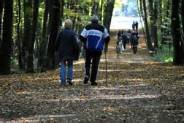December 14, 2014
 You have heard the proverbial saying “you can’t see the forest for the trees”. Sometimes with exercise we miss the big picture because we are focused on the details.
You have heard the proverbial saying “you can’t see the forest for the trees”. Sometimes with exercise we miss the big picture because we are focused on the details.
Let’s start with cardiovascular exercise today.
The invention of heart rate monitors has made heart rate a focus for getting a “good” cardio workout. In fitness, heart rate gives us a clue to the many other things happening in the body during exercise.
Cardiovascular exercise was invented to challenge the heart and vascular system and make the system more efficient. It was invented because we have less need to move for prolonged bouts, like walking long distances as we did before transportation was done on wheel and rail. (think of “Little House on the Prairie” – or if you are younger than me – think of the reality show “Homestead”.)
So doing cardio is actually an attempt at an artificial replacement for the longer bouts of movement we probably did several times a day, each day before the industrial revolution.
Studies in exercise science determined the minimal amount of exercise is 30 min of continuous movement at a moderate to p ace, at least three days a week to challenge the cardiovascular system to get stronger in a measurable way. The main way to measure this is how much oxygen the body uses at different intensities of exercise.
ace, at least three days a week to challenge the cardiovascular system to get stronger in a measurable way. The main way to measure this is how much oxygen the body uses at different intensities of exercise.
But its not at all practical for the average exerciser to measure how much oxygen is used when we exercise. Fortunately, heart rate mostly increases at the same rate that oxygen use increases. Thus why heart rate monitors are used. Just keep in mind what we are really trying to measure here.
If the goal is to just get our heart rate up, than heck, let’s just all sit around and drink coffee. Or, for a more effective workout, be stressed and drink coffee. Wait a minute… that sounds familiar?? Anyone feel like they got a great cardio workout at their office job? It got the heart rate up, but… it is not that simple.
When we move continuously, the MUSCLE cells send signals that there is more carbon dioxide being produced and that more oxygen is needed to keep moving. The carbon dioxide build up is actually what tells the body to breathe faster – to get rid of the carbon dioxide.
The real challenge to the heart muscle itself is the extra blood flowing back into the heart from the moving muscles. As a larger volume of blood fills the heart with each beat – it beats STRONGER. Each stronger contraction over time strengthens this muscle. So it is the stronger contraction that is important – not necessarily the heart beating faster.
Again… this is not even that simple. We are training the whole system. New blood vessels grow in the heart and the exercising muscles so there is more blood flow there. There are many, many more things that happen, I could go on and on, but I won’t. Just know that everything along that system gets a boost. We are trying to strengthen every part of that system, not just the heart.
And not only the cardiovascular system, but it signals other systems to improve as well– the endocrine system (ie: improved blood sugar), the nervous system (ie: chemicals that boost mood) the immune system, etc.
Heart rate can be a helpful tool when used correctly– but please remember it is just one “tree” in the a vast forest. Just one measure of what is happening. Helpful but not the whole forest by any stretch of the imagination.
 All this forest talk makes me want to go for a walk in the woods!
All this forest talk makes me want to go for a walk in the woods!
Have a great week!
Keep Moving, Be Well,
Janet
Janet Huehls, MA, RCEP, CHWC







Great post Janet >
LikeLike
Pingback: Heart Rate Monitoring + Medications | Keep Moving Weekly